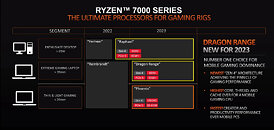Raevenlord
News Editor
- Joined
- Aug 12, 2016
- Messages
- 3,755 (1.25/day)
- Location
- Portugal
| System Name | The Ryzening |
|---|---|
| Processor | AMD Ryzen 9 5900X |
| Motherboard | MSI X570 MAG TOMAHAWK |
| Cooling | Lian Li Galahad 360mm AIO |
| Memory | 32 GB G.Skill Trident Z F4-3733 (4x 8 GB) |
| Video Card(s) | Gigabyte RTX 3070 Ti |
| Storage | Boot: Transcend MTE220S 2TB, Kintson A2000 1TB, Seagate Firewolf Pro 14 TB |
| Display(s) | Acer Nitro VG270UP (1440p 144 Hz IPS) |
| Case | Lian Li O11DX Dynamic White |
| Audio Device(s) | iFi Audio Zen DAC |
| Power Supply | Seasonic Focus+ 750 W |
| Mouse | Cooler Master Masterkeys Lite L |
| Keyboard | Cooler Master Masterkeys Lite L |
| Software | Windows 10 x64 |
AMD has confirmed its revamped APU strategy will be delivered throughout three different APU line-ups come 2023. While Raphael will take care of AMD's hopes in the desktop space, the company is readying a new, "Dragon Range" lineup of "pinnacle gaming"-oriented APUs, leveraging the company's upcoming Zen 4 architecture, DDR5, and PCIe 5. Dragon Range APUs will feature the "highest core, thread, and cache ever for a mobile gaming CPU" - although AMD stopped just short of confirming exactly what "highest" translates to. To aid in its extreme gaming aspirations, TDP for Dragon Range is set at 55 W - they thus "largely exist in the space where gaming laptops are plugged in the majority of the time," according to AMD director of technical marketing Robert Hallock.
Another APU family, Phoenix, will be aimed at thin and lights with a penchant for gaming. Phoenix too will leverage AMD's Zen 4 core, DDR5 memory subsystem, and PCIe 5 interfaces. Being aimed at thin and lights, Phoenix APUs are set for a 35 W - 45 W operating range. Interestingly, AMD didn't share any other details - more crucially, the graphics architecture that's to be employed in these high-performance APUs.

With RDNA3 products hitting the ground running sooner rather than later, it remains to be seen if AMD will take Intel's increased competition in the graphics space as a hint to provide the latest graphics architectures in its APU offerings, or if the company will keep a steadfast improvement to performance as it catches up the APU graphics IP to the latest and greatest.
View at TechPowerUp Main Site | Source
Another APU family, Phoenix, will be aimed at thin and lights with a penchant for gaming. Phoenix too will leverage AMD's Zen 4 core, DDR5 memory subsystem, and PCIe 5 interfaces. Being aimed at thin and lights, Phoenix APUs are set for a 35 W - 45 W operating range. Interestingly, AMD didn't share any other details - more crucially, the graphics architecture that's to be employed in these high-performance APUs.

With RDNA3 products hitting the ground running sooner rather than later, it remains to be seen if AMD will take Intel's increased competition in the graphics space as a hint to provide the latest graphics architectures in its APU offerings, or if the company will keep a steadfast improvement to performance as it catches up the APU graphics IP to the latest and greatest.
View at TechPowerUp Main Site | Source





 ).
).